
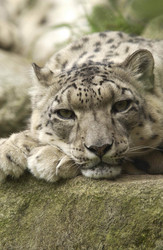
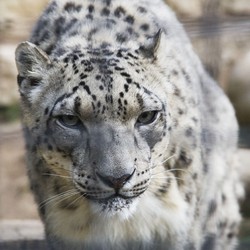
Left: Snow Leopard at Woodland Park Zoo, Seattle, WA
© 2008 photo by Dennis Conner, courtesy of Snow Leopard Trust. Right: Snow Leopard at San Diego Zoo, © 2007 Joe Nicora
Introduction
In 1972, the World Conservation Union (IUCN) placed Snow Leopards on the endangered species red list, the same classification given to Giant Pandas and Siberian Tigers. In 1975, under the Convention on International Trade of Endangered Species (CITES), trafficking of live snow leopards and their fur or body parts was made illegal in much of its native habitat. Today, almost 40 years later, the population of these beautiful big cats is still declining dangerously. Why? What can be done to help? This treehouse will provide information regarding many aspects of Snow Leopards with the hope of promoting conservation not only for these big cats, but also for other endangered species.
Kitty Facts
Classification
There has been some debate over the classification of Snow Leopards. Molecular studies suggest commonalities with big cats among the genus Panthera, such as Lions (Panthera leo), Tigers (Panthera tigris), Jaguars (Panthera onca) and Leopards (Panthera pardus). However unlike these big cats, Snow Leopards do not have the anatomical ability to roar, and so taxonomists sometimes place them in their own genus Uncia. Although they cannot roar, they do growl, moan, hiss, and mew just like other felines. Many experts believe they are an intermediate species between big cats and smaller felines, similar to the Clouded Leopard (Neofelis nebulosa).
Habitat and Range
Snow Leopards are native to high mountain ranges in central and south Asia extending through twelve countries: Afghanistan, Tibet, India, Pakistan, Kazakhstan, Russia, the Kyrgyz Republic, Bhutan, Mongolia, Nepal, Tajikistan, and Uzbekistan. Although this total range seems extremely large, the areas where the cats are usually found are relatively small and fragmented. In these regions, Snow Leopards spend much of their time 3,000 to 5,400 meters above sea level. At these elevations, the environment is cold and dry, while the terrain consists chiefly of very steep, rocky slopes. The only time these cats can be found at lower elevations is during the coldest winter months, when they follow their prey to the lowland forests that cover some of their homeland.
Perfectly Built for Their Extreme Habitat
Weighing between 30 and 60 kilograms, Snow Leopards are slightly smaller than other Leopards. They stand roughly 2 feet tall at the shoulder, and reach lengths of 6-8 feet from their head to the tip of their tail. They possess many unique adaptations which enable them to live in such a harsh climate.
Tail: Growing the length of its body, a Snow Leopard's tail is one of its most distinguishable and beneficial features. When hunting, Snow Leopards stalk their prey high up on mountain ridges. They then leap down, sometimes more than 40 feet, to chase and attack their target. The cats meter long tail aids in this process by helping them keep their balance while leaping and running among the steep mountain slopes. Not only is the tail used for balance, it is also used for warmth in the harsh cold climate. Snow Leopards are often seen with their tail wrapped around their face, protecting their noses from frost-bite.

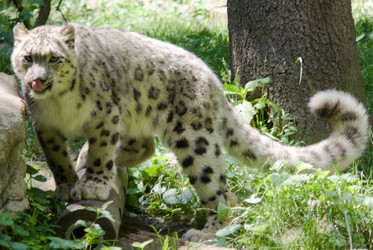
Snow Leopard at Bronx Zoo, © 2007 David Creswell
Fur: Its beautiful coat is perfectly coloured for camouflage among the steep rocky slopes of a mountainous habitat. This helps the Snow Leopard sneak up on prey, but it also makes it very difficult for scientists to find them when doing research. Its thick, dense fur can grow up to 12 cm long, which provides much needed warmth in the often bitterly cold region. Unfortunately these features also make the Snow Leopard a target for the fur trade. Although the trafficking of Snow Leopard fur was made illegal many years ago, pelts are sold on the black market in Central Asia, Eastern Europe, and Russia where coats and other garments are quite popular.

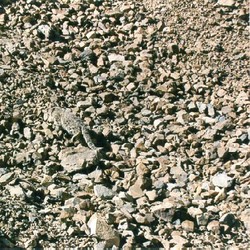
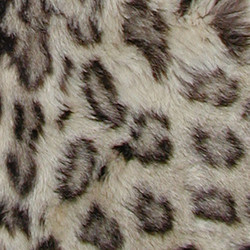
Left: Can you spot the Snow Leopard among the rocks? Right: Snow Leopard rosettes. Images © 2008 Snow Leopard Trust
Paws: Their large, fur-covered feet act as snowshoes, slippers, and aide in balance all at the same time. Unfortunately, their paws, among other body parts, are also in demand for use in traditional Asian medicine.
Respiration: Powerful lungs and a large chest capacity help Snow Leopards get the oxygen they need from the thin mountain air. They also possess an enlarged nasal cavity which warms the cold air they breathe before it reaches the lungs.
Behaviour
Being very shy creatures, Snow Leopards are rarely seen in the wild. However through much hard work and collaboration, researchers have been able to piece together much about the behavioural patterns of these elusive cats.
Feeding: Being an opportunistic feeder, Snow Leopards will kill and eat whatever meat they can find. This includes wild game native to the area such as Ibexes and Bharal, as well as Pikas, Marmots and other small rodents. However due to increasing human encroachment into Snow Leopard territory, the big cats have also been known to attack domestic livestock. Unfortunately herders’ economic stability relies heavily on their domestic animals, and they often retaliate to such killings with a vengeance.
Reproduction: Being largely solitary creatures, individual Snow Leopards are rarely seen with others. The exceptions are during mating season, or when a mother is rearing her cubs. Females become sexually mature around 2-3 years of age, and males at 4 years. A single pair will be together for a short period between January and mid-March after which the male leaves the female to raise the cubs. Female snow leopards are pregnant for about three months before giving birth to 2-3 cubs. Like other felines, cubs are quite helpless when they are born and do not open their eyes for 7 days. By 2-3 months, they are eating solid food and following their mother around, but they do not become independent until 18-22 months of age. As a result, female snow leopards give birth every other year.

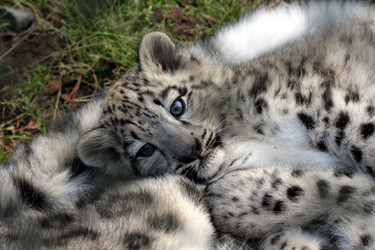
Baby Snow Leopard at Ähtäri Zoo, Finland © 2006 Frans Mäyrä
Territory Markings: Individual snow leopards inhabit a defined home range. These home ranges may vary greatly in size depending on the abundance of prey. To avoid potential conflict and find mates, Snow Leopards mark their territory. They do this in a number of ways, including spraying urine against rocks, defecating in specific areas, or scraping the ground with their hind legs. Scientists also use these marks while tracking and researching Snow Leopards.
Aggressive Tendencies: Snow Leopards have a crepuscular activity pattern, which means they are most active at dawn and dusk. When there is a significant human presence, however, they have been known to become primarily nocturnal in order to avoid contact. On the rare occasion when there is contact with humans, Snow Leopards are rarely aggressive. Even if they are disturbed while feeding, the big cats are more likely to run away than try to defend their kill. Only if they feel threatened, or their cubs are threatened will they display aggressive behaviour.
Population and Threats
Due to the Snow Leopard's shy, solitary nature, and the inaccessibility to its habitat, population sizes are quite difficult to estimate. It is thought that 4,500 – 7,500 remain in the wild with an additional 600 – 700 in zoos worldwide. Unfortunately these numbers continue to decline. A number of factors influence Snow Leopard populations, the main threat being human activity.
Poaching
Snow Leopards are hunted illegally for many of their body parts. Their lustrous fur is made into coats, hats and other garments. Pelts sell for thousands of dollars on the black market, and it typically takes 6-12 skins to make one coat. Snow Leopard skeletons sell for twice the amount of their furs. Over the past five years, their bones have become in demand as a substitute for Tiger bones in traditional Asian medicine. With so much media and conservation attention, Tiger bones are becoming difficult for poachers to acquire, so they have turned to alternative felines. Many poachers are local people from Snow Leopard areas who are barely able to survive on a few dollars a day. To them, poaching is an extra source of income to help feed their families.

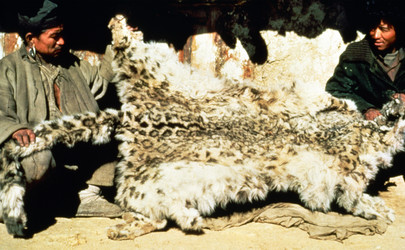
Snow Leopard pelt in Nepal © 2008 photo by Rod Jackson, courtesy of Snow Leopard Trust.
Conflict with Herders
When Snow Leopards and humans come into close contact, conflict usually arises. The cats often attack livestock because they are much easier to stalk and kill then wild prey. Herders in the area depend heavily on the well being of their animals, and so the loss of a single sheep, goat or horse presents a huge setback. Herders often retaliate for these losses by poisoning, shooting or trapping Snow Leopards. Killings of this nature rarely get reported, and so the number of Snow Leopards killed in this manner is unknown.
Habitat and Prey Loss
The habitat to which the Snow Leopard has adapted is a very specific and fragile environment. These snow covered mountanous areas are being threated by both global warming and the encroachment of humans. Snow Leopards typically inhabit the area between the tree line and the permanent snow line. Temperature changes have caused the permanent snow line to recede, which causes the Snow Leopards to move further up mountain slopes. At these high elevations, vegetation is scarce, as are the herbivorous animals on which the big cats prey. Not only is global warming posing a threat, but as humans become more mobile, they push further into Snow Leopard territory. Livestock overgraze and damage mountain grasslands, leaving less food for the big cats' wild prey. This situation also increases conflict with local herders since livestock is more likely to be killed when natural prey is scarce.
Lack of Cooperation, Policy Implementation and Funding
There is no shortage of laws designed to protect the Snow Leopard, but creating laws is only half of what is required. Implementing these laws requires cooperation between not only governments and conservation agencies, but also the general public. Local people in Snow Leopard areas are struggling to provide for themselves and their families. They have little time or energy to devote to the protection of these felines. Similarly, many governments in Snow Leopard areas are focused on other issues. Environmental protection policies are usually not a top priority when governments need to worry about economic development or political instability. This also leaves very little money to enforce laws and patrol protected area boundaries for poachers.
Why are they so Important?
Indicator Species
The presence, absence, or relative well-being of an indicator species in its environment indicates the heath of the surrounding ecosystem as a whole. Being one of the top predators in the high mountain food web of Central Asia, the Snow Leopard helps to keep the ecosystem in balance by preying on marmots, ibexes and other native herbivores. If there are too many herbivores in the area, they will degrade the alpine meadows, leaving no food for both wild herbivores and domesticated livestock. If Snow Leopards disappear from the area, the rest of the ecosystem will fall apart.
Native Beliefs
There are many ancient beliefs and traditions surrounding the Snow Leopard in areas where they are commonly found. Many have been preserved for centuries and are still incorporated into some religious rituals today.
Nepal: In northern Nepalese societies, many indigenous and shamanistic practices incorporate the Snow Leopard. Some folklore describes Snow Leopards as a "fence" for crops, meaning that if there are none around, native animals would be free to invade crop fields. Other inhabitants believe Snow Leopards are born to remove sins from past lives, and that killing one means transferring their sins to your own life.
Tibet: Milarepa, one of Tibet's most famous poets and yogis, is said to have transformed himself into a Snow Leopard while stranded on a mountain in the winter. By doing this, he was able to survive six months until his disciples could travel up the mountain and search for him.
The Wakhi: The Wakhi are a group of people native to northern Pakistan, China, Tajikistan and Afghanistan. They believe that supernatural beings, called mergichan, inhabit the high mountains of the region. The mergichan are holy and very powerful, and so the area they inhabit is pure and sacred. The Wakhi believe the mergichan often take the form of a Snow Leopard, since the animal exemplifies many of the qualities of the mergichan: elusive, powerful, beautiful, and potentially dangerous.
What is being Done to Help?
Since 1972 when Snow Leopards were first placed on the endangered species list, many things have been done to try to save these magnificent creatures.
Local Governments
Various international and national treaties and laws protect the Snow Leopard. All Snow Leopard range countries except the Kyrgyz Republic and Tajikistan have made the trafficking of live Snow Leopards or their fur/body parts illegal. A number of governments have also created national parks in order to preserve and protect Snow Leopard habitat.
Protected areas include:
- Chitral Gol National Park, in the N.W.F.P province, Pakistan
- Hemis National Park, in east Ladakh, India
- Khunjerab National Park, Northern Areas, Pakistan
- Nanda Devi National Park, in the state of Uttarakhand, India
- Qomolangma National Park preserve, Tibet, China
- Sagarmatha National Park, Nepal
- Tumor Feng Nature Reserve, Western Tianshan mountains, Xinjiang, China
- Valley of Flowers National Park, Uttaranchal, India
- Shey-Phoksundo National Park, Dolpa, Nepal
- Dhorpatan Hunting Reserve, Baglung, Nepal
- Annapurna Conservation Area, Western Nepal
- Jigme Dorji National Park, Bhutan
- Gobi Gurvansaikhan National Park, Mongolia
- Ubsunur Hollow, on the territorial border of Mongolia and the Republic of Tuva
Conservation Agencies
Many private conservation agencies have also been created to save the Snow Leopards. These agencies implement a number of different programs aimed at research, education and preservation.
Research: In these programs, scientists go out into Snow Leopard territory to try to learn as much about the animals as possible. Wild Snow Leopards are rarely seen, therefore indirect methods are usually used to track animals and estimate population sizes. Indirect studies include setting up cameras or analyzing trails left by Snow Leopards including tracks, scrapings, feces, or urine-sprays. Scientists also observe the herds of wild sheep and goats that are the Snow Leopard's primary prey. Population sizes of native herbivores can indicate how many Snow Leopards are potentially in the area. Genetic studies are also in their early stages to help design new conservation programs and evaluate old ones.

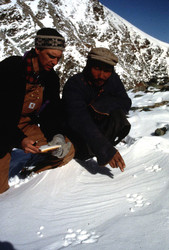
Researchers in Mongolia following Snow Leopard tracks © 2008 Snow Leopard Trust
Local Village Programs: Many conservation agencies have set up programs in local villages near Snow Leopard territory with many different goals. One of the most important is to help local herders protect their livestock from Snow Leopard attacks. Wire mesh and wood is provided to cover unprotected windows in stables. If an animal is attacked, many conservation agencies also have an insurance program designed to compensate families for their loss. In return, herders agree not to kill Snow Leopards and to leave some room for the Snow Leopard's prey species to graze. Herders are also encouraged to dismantle traps, report sightings of Snow Leopards, record livestock losses due to attacks, and practice the best possible livestock guarding techniques. Other programs aim at improving the economy of local communities. Villages are provided with equipment to produce products made from the wool of their sheep and camels. The products are then sold at local tourist attractions, or the conservation agencies may sell them online.
Information on the Internet
- Snow Leopard Trust Conservation agency working to protect the Snow Leopard along with its habitat. Provides a lot of Snow Leopard information, pictures, and ways to help.
- Snow Leopard Conservancy Another great organization dedicated to the protection of Snow Leopards. Provides very detailed information about what has been done so far to help, and plans for the future.
- Arkive: images of life on earth Includes lots of Snow Leopard information along with images and videos
- National Geographic Includes a lot of Snow Leopard information, along with a distribution map.
- San Diego Zoo Hear a Snow Leopard growl
- International Union for Conservation of Nature Works toward the conservation of all endangered species on the planet, and their ecosystems.




 Go to quick links
Go to quick search
Go to navigation for this section of the ToL site
Go to detailed links for the ToL site
Go to quick links
Go to quick search
Go to navigation for this section of the ToL site
Go to detailed links for the ToL site